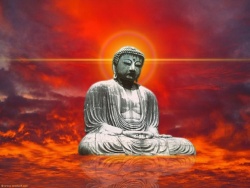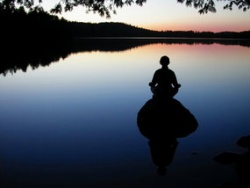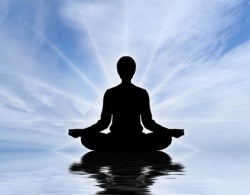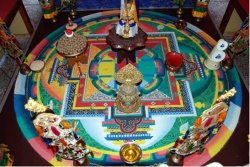Vipassana and the Art of Peaceful Living by S. N. Goenka
WORKING TOWARDS THE RESTORATION OF PEACE
Everyone wants peace and harmony, everyone wants happiness. I feel deeply pleased that the theme of this gathering accords with the noblest aspiration of man: to search for the knowledge which can lead to peace, harmony and happiness.
The twentieth century has witnessed tremendous advances in science and technology. Immense avenues have opened up for material comforts and ease. Yet we find man’s mind is not at ease. High tension is the hallmark of modern man.
As we stand at the threshold of the dawn of the twenty-first century, the stark reality is that humanity is facing a grave crisis. The deep erosion of moral values, the paradox of affluence and abject poverty coexisting, pervasive violence and crime, ethnic, racial and religious conflicts, and deep antagonism between man and man — all thwart the very existence of human civilization. We see conflicts everywhere — between individuals, families, communities and nations — and no one seems to be at peace.
Confronted with an almost similar situation about 26 centuries ago, Prince Siddhartha Gautama made a supreme effort, unparalleled in the annals of human history, in the quest for a solution to the all-pervading phenomenon of misery. In that process he rediscovered the ancient technique of vipassana, the most sublime and noblest heritage of India. Through its practice he eradicated all his defilements, achieved purity of mind, and became a sammasambuddha, a fully enlightened one. Then with love and compassion he started distributing the technique to suffering humanity.
Millions of people in India benefited from this technique. The benevolent message of vipassana went beyond the shores of India and made a deep impact in neighbouring countries. The great emperor Ashoka used this technique as the principal instrument of his public policy in the governance of his vast empire, as his rock edicts clearly amplify. India achieved a high degree of progress in all spheres of life, material and spiritual, and was hailed as the ‘world teacher’. Indeed, the contribution of India to the cause of peace, harmony and good order was profound.
About 500 years after Buddha passed away, the technique of vipassana was lost in India. But fortunately it was preserved in its pristine purity in Myanmar by a chain of teachers. Sayagyi U Ba Khin, my distinguished teacher and a renowned exponent of vipassana, has the desire that the jewel of vipassana should go back to India, the country of its origin, and spread to the whole world for the peace, good and happiness of suffering humanity. Vipassana has thus come to India. With this brief historical background let us understand what vipassana is.
At this stage let us be clear that in our quest for peace and harmony in society, the individual is the key. Man matters most. For society to change for the better the individual has to change. When the entire forest has withered, each tree has to be nurtured — its roots cleared of disease and then watered. Then the entire forest will bloom again. Similarly, for the betterment of society each individual has to improve.
Now, let us reflect. What is the cause of the lack of peace and harmony in the individual, and therefore of peace and harmony in society? If one investigates the problem, it becomes clear that whenever one starts generating any negativity or defilement in the mind, one is bound to be agitated. A negativity in the mind, a mental defilement or impurity, cannot coexist with peace and harmony.
How does one start generating negativity? Unwanted things happen and create tension. Wanted things do not happen, or obstacles come in the way, and one generates tension. One keeps on tying knots, Gordian knots, and makes the entire mental and physical structure tense and full of negativity. Life becomes miserable.
One way to get rid of negativity and achieve peace and harmony is to divert one’s attention to any object of sensual pleasure. But this gives only temporary relief as the peace one experiences is limited to the surface level of the mind. The behaviour pattern of the mind at the root level does not change.
Therefore the great explorer of inner truth went still further in his search. By experiencing the reality of mind and matter within himself, he recognized that diverting one’s attention is only running away from the problem. Escape is no solution. One must face the problem. Just observe the negativity that has arisen and it will be eradicated.
But it is difficult, nearly impossible, for a common person to observe abstract negativity and get rid of it. Hence one who reached the ultimate truth found a real solution for everyone. He discovered that whenever any defilement arises in the mind, two things start happening at the physical level. One is that the breath loses its normal rhythm — one starts breathing slightly harder at the gross physical level, and at a subtler level some kind of biochemical reaction starts within the body manifesting as some sensation. Every defilement generates a sensation of one kind or another in some part of the body.
This mental-physical phenomenon is like a coin with two sides. On one side is whatever thought or emotion that arises in the mind, and on the other side are respiration and sensations in the body. Any thought or emotion, conscious or unconscious, and any mental defilement, manifests itself in the breath and bodily sensations of that moment. Although it is difficult to observe abstract negativity, one can easily learn how to observe breath and sensations. Thus by objective observation of these corporeal phenomena one is observing mental defilement. Instead of running away from the problem one is facing reality as it is. One soon finds that the defilement loses its strength, it can no longer overpower as it did in the past. If one continues the practice, the defilement eventually disappears altogether. One becomes peaceful and happy. This peace is not temporary, because with repeated practice one is able to change the habit pattern of the mind at the deepest level and thus get liberated from the misery experienced due to negativities.
When one reaches this stage, the entire pattern of one’s life starts changing. It is no longer possible for one to do anything vocally or physically which will disturb the peace and happiness of others. One realizes that the entire cause of misery lies inside. Similarly the entire cause of happiness also lies inside, not outside. Just as man matters most in the quest for peace in society, similarly the mind matters most in the quest for peace in the individual. The root of every unwholesome action, vocal or physical, is the mind. One cannot kill unless one generates anger, hatred, ill-will or animosity. One cannot steal unless one generates greed. Sexual misconduct is impossible unless one generates passion.
Before one harms others, one actually harms oneself. As soon as one generates negativity in the mind, one becomes miserable. One becomes the first victim of one’s own negativity. The law of nature is such that one is punished, there and then. It takes time for the laws of government to ensure that one is punished for a crime, but the law of nature does not wait.
A negative mind not only becomes agitated and miserable in itself, it causes misery for others. The atmosphere surrounding such a person will be permeated with agitation and tension and this will start affecting others. Similarly a balanced mind not only becomes peaceful in itself but helps others also to become peaceful. The atmosphere surrounding such a person will be permeated with peace and harmony and this will start affecting others too. It is this experiential understanding that will lead to improvement at the level of the individual and consequently at the level of society.
This is what Buddha taught, an art of living. He taught the technique of vipassana to observe nature as it is by observing the realities inside. Out of ignorance one keeps reacting in a way which is harmful to oneself and harmful to others. When one ceases to react blindly, then one is capable of real action which is always positive, creative, helpful to oneself and helpful to others.
By this technique of self-observation, introspection, one learns to stop reacting blindly, to stop creating defilements. Naturally, old defilements are gradually eradicated. One comes out of all miseries and experiences lasting happiness.
To learn this technique one has to join a residential retreat of ten days. There are three steps to the training. The first prerequisite is that one has to observe five precepts. One has to abstain from killing, stealing, sexual activity, telling lies and taking intoxicants.
Observing these precepts, one is in a position to explore the truth as it is within the framework of one’s own body. Sitting down with eyes closed, the aspirant directs his attention within the framework of the body and observes the natural breath as it comes in and goes out. One does not regulate the breath, it is not a breathing exercise or pranayama: one just remains aware of the flow of the natural breath. If it is deep, one is aware that it is deep; if it is shallow one is just aware that it is shallow. Mere observation, bare observation, without any reaction, without giving any valuation. The technique is to observe the reality manifesting itself from moment to moment without any reaction.
A wonderful beginning is made. One has started observing the truth pertaining to oneself — the truth of the functioning of mind-matter phenomena. With one’s own experience one will find that as and when a defilement arises in the mind — anger, hatred, passion, fear — the breath loses its normality. It becomes hard, fast. And when that particular defilement has passed away the breath will again become normal. So breath is strongly related to one’s mind and mental defilements.
The practice doesn’t involve any blind faith or sectarian philosophical dogma. There is no verbalization in this technique, no visualization, no imagination. One is working with reality; one is exploring the truth that one experiences. Practising thus, one sees that the mind is calming down, getting a little concentrated. It is quite true that by using words or by imagining a shape or form along with the awareness of respiration, it becomes easy for the mind to get concentrated. But the final goal of this technique is not mere concentration but actually the purification of the mind. The mind may become fully concentrated on craving, aversion, illusion or delusion. But the aim of vipassana is to make it free from all of these.
Observing moral precepts and achieving a modicum of control over the ever-fleeting mind are the first two stages of training. The student of vipassana then embarks on the third stage, deeper investigation of mind-matter phenomena.
Focusing on a small triangular area with the base at the upper lip and covering the area of the nostrils, the mind becomes more sensitive and subtler realities start manifesting themselves. One starts feeling different types of sensations. They may be sensations of heat or cold or perspiration, they may be throbbing, pulsating, vibrating, or tingling, they may be sensations of expansion, contraction, or maybe dryness. One has not to look for a particular sensation. It is a choiceless observation. Let nature play its role, one has just to observe.
As the practice develops the student starts scanning the entire body from head to feet and from feet to head, surveying each and every part of the body, each and every particle of the body. One finds that there are sensations everywhere — some biochemical reaction or the other, some electromagnetic reaction or the other — every moment on every little part of the body. One starts experiencing it, and the technique is just to observe, never to react. Awareness and equanimity are the crux of the practice. So for the rest of the ten-day period the student trains himself to observe sensations objectively.
What does one attain by this? How is it beneficial? One starts exploring the truth pertaining to oneself by direct experience. One starts realizing the truth about the working of mind-matter phenomena: how mind and matter interact and influence each other. How mental impurities are generated, resulting in misery, and how they can be eradicated. The meditator realizes that as respiration and mental impurities are strongly related, similarly bodily sensations and mental defilements are strongly related. The so-called unconscious or subconscious mind remains in contact with the body sensations day and night. The unconscious mind reacts whenever there is any sensation in the body, pleasant or unpleasant. If it is pleasant it reacts with craving and a clinging raga. If it is unpleasant it reacts with aversion, dvesha. It has become a prisoner of this habit pattern.
One has to go the depth of the mind, the so-called unconscious mind. In the language of India of those days, it was called alaya chitta, the storehouse of the mind. All our mental complexes, conditioning, and behaviour patterns are stored there. They keep on flowing with the flow of the mind, and from time to time they come to the surface and overpower us. The impurities, the defilements, the negativities stored there were called, in the language of those days, anusaya kilesa, latent impurities like sleeping volcanoes. At any moment they can explode and overpower. So long as one harbours these impurities one is not free from misery. One has to train the deepest level of the mind not to react with craving or aversion in spite of feeling pleasant or unpleasant sensations. The barrier between the conscious and unconscious minds is broken by vipassana, by this technique of observation.
As one starts observing the reality pertaining to matter and to the mind, it becomes very clear that whatever arises, arises just to pass away. One observes that a sensation which has arisen, whether pleasant or unpleasant, will sooner or later pass away. Ignorantly one keeps on calling one’s physical structure ‘I’, ‘mine’, and develops so much attachment towards it that it becomes a real bondage. If it is indeed ‘mine’ then one should have control over it. But one has no control. Things just happen, due to the universal law of cause and effect. What is this physical structure, after all? It is nothing but a mass of subatomic particles. By experience one finds that the entire physical structure is nothing but tiny little particles, tiny little wavelets, arising and passing with great rapidity.
So also mental structure, which is nothing but wavelets arising and passing, constantly changing. This is what the Enlightened One found — that the entire physical structure, the mental structure, and the combination of the two is nothing but vibrations. Sabbo loko pakampito: The entire universe is vibrating.
At the experiential level, when we start understanding the law of nature, we realize that the moment we generate any negativity there is an unpleasant vibration which makes us unhappy and agitated.
Outside objects are not the real cause of suffering — they are only apparent causes. Whatever we experience in life is encountered through our six sense doors. When the six sense doors come in contact with their respective sense objects — vision with the eyes; sound with the ears; smell with the nose; taste with the tongue; something tangible with the body; or a thought with the mind — a sensation immediately starts in the body, either pleasant or unpleasant, according to the evaluation we have given to the objects outside.
If the sensation is pleasant we start reacting with craving and become miserable. If the sensation is unpleasant we start reacting with aversion and become miserable. This is what the words of the Enlightened One refer to Vedana pacchaya tanha: with the base of sensation, craving and aversion arise. The missing link that was discovered by the Buddha is vedana, the sensation in the body. If one is ignorant of this, one directs all efforts to rectify things outside. One does not rectify things inside, where the root cause of the misery lies.
With the practice of vipassana one understands the interaction of mind and matter within oneself. One realizes the whole process of the arising of misery and the eradication of misery at the experiential level. It is so scientific. Whenever any negativity arises in the mind there starts a secretion of an unpleasant flow of biochemical substances in the blood vessels. This helps to increase the negativity, which in turn increases the flow of biochemicals. Thus the vicious circle continues to multiply the misery. In the ancient language of India this flow of unpleasant biochemicals was called asava or asrava. Buddha found the technique of vipassana, through which one can become anasavo or anasrava — that is, free from the misery of this biochemical flow of negativity.
Vipassana is a technique of truth realization, of self-purification through self-observation. By practising vipassana one eradicates defilements from the deepest level of the mind. The mind becomes pure, full of infinite love, infinite compassion, infinite sympathetic joy, infinite equanimity. These are the basic characteristics of a pure mind, and all actions which emanate from a pure mind are full of peace, harmony and goodwill.
Dhamma, or dharma, means truth, the law of nature. Vipassana helps one to realize this universal law of nature and get tuned to it. This is how one learns to live peacefully and harmoniously. Each and every member of human society can practise vipassana and get the same benefits. The technique is universal and non-sectarian. One may be from any religion or any country, it makes no difference. The human mind is the human mind. Vipassana can become an instrument in generating human values and integrating human society by eliminating all racial, ethnic and communal conflicts and other disintegrating factors.
People from every caste, community, religion, and background are taking part in vipassana courses. There are even courses for children. And courses are being organized for prison inmates and members of staff in several states, including Tihar Central Jail in the capital city of India. The impact has been profound. Within the prisons, hardened criminals, drug addicts and habitual offenders are coming out with deep remorse and a resolve to change their habits and lead healthy, peaceful, harmonious lives.
Furthermore, leaders of various religious systems and social groups — monks and nuns, munis, sadhvis, sannyasis and yogis, Christian priests and nuns — are joining in large numbers. And senior government officials, members of public and private sector organizations and institutions of higher learning are taking advantage of the technique as an effective instrument of education and reform.
In view of the magnitude of the problems that human society is confronting today, a very small beginning has been made. Vipassana beckons to all those who are dedicated to the noble pursuit of peace, harmony and human welfare. Let them try this wonderful technique of human development.
May you enjoy peace, may you enjoy harmony, may you enjoy happiness.








